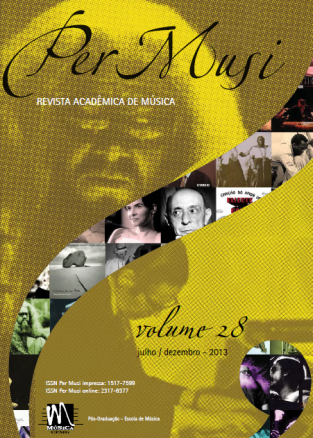Variação Progressiva de Schoenberg em Hermeto Pascoal
análise e realização de duas lead sheets do Calendário do som
Palavras-chave:
Calendário do som de Hermeto Pascoal, Teoria tonal de Arnold Schoenberg, Análise da música popular brasileira e realização de cifras, Variação progressiva na música popularResumo
Terceira parte de estudo relacionando Arnold Schoenberg e Hermeto Pascoal em relação à harmonia tonal. Aqui adaptamos e aplicamos os conceitos de Forma e Variação Progressiva de SCHOENBERG (1994, 2006), juntamente com outros conceitos (SCHOENBERG,1984, 1993, 1999, 2001, 2004) abordados em artigo anterior (ARAÚJO e BORÉM, 2013, às p.35-69 desse número de Per Musi) na realização de duas canções instrumentais do livro de partituras Calendário do som de Hermeto Pascoal: 23 de junho de 1996 (PASCOAL, 2000a, p.23), e 9 de Junho de 1997 (PASCOAL, 2000a, p.374), cujas partituras (PASCOAL, 2013a e 2013b) são apresentadas às p.96-98 e p.99-101 desse desse número de Per Musi.
Referências
ARAÚJO, Fabiano; BORÉM, Fausto. A Harmonia tonal de Schoenberg: uma proposta para a análise, realização e composição de lead sheets. Per Musi. n.28. Belo Horizonte: UFMG, 2013. p.35-69.
BORÉM, Fausto; ARAÚJO, Fabiano. Hermeto Pascoal: experiência de vida e a formação de sua linguagem harmônica. Per Musi, n.22. Belo Horizonte: UFMG, 2010. p.22-43.
BORÉM, Fausto; FREIRE, Maurício. Cannon de Hermeto Pascoal: aspectos musicais e religiosos em uma obra-prima para flauta. Per Musi, n.22. Belo Horizonte: UFMG, 2010. p.63-79.
BUETTNER, Arno Roberto von. Expansão Harmônica: uma questão de timbre. São Paulo: Irmãos Vitale, 2004.
CUGNY, Laurent, Analyser le jazz. Paris: Outre Mesure, 2009.
DUDEQUE, Norton, E. Music Theory and Analysis in the Writings of Arnold Schoenberg (1874-1951). England: Ashgate, 2005.
_______. Schoenberg e a Função Tonal. Revista Eletrônica de Musicologia. Dep. Artes da UFPR. v.2, n.1.1997._______. Variação progressiva como um processo gradual no primeiro movimento do Quarteto A Dissonância, K 465, de Mozart. Per Musi. v.8, jul-dez. Belo Horizonte: UFMG, 2003. p.41-56.
FREIRE, Nelson; SALLES, João Moreira. Uma frustração. In: Nelson Freire: um filme sobre um homem e sua música (2003). Filme de João Moreira Salles, 2003. Vídeo de 01 hora, 36 minutos e 51 segundos, postado no Youtube por “Docspt Arte” em 16 de outubro de 2012. (2003. Acesso em 25 de janeiro 2013).
LEVINE, Marc, The jazz piano book. Berkeley: Sher Music,CO., 1989.
PASCOAL, Hermeto. 9 de Junho de 1997. In: Calendário do som. São Paulo: Editora Senac, 2000a. p.374. (Partitura musical em forma de lead sheet).
_____. 9 de Junho de 1997 (Calendário do som): manuscrito e lead sheet de realização. Realização e edição de Fabiano Araújo. Per Musi. n.28. Belo Horizonte: UFMG, 2013b. p.99-101.
_____. 23 de junho de 1996. In: Calendário do som. São Paulo: Editora Senac, 2000b. p.23. (Partitura musical em forma de lead sheet).
_____. 23 de junho de 1996 (Calendário do som): manuscrito e lead sheet de realização. Realização e edição de Fabiano Araújo. Per Musi. n.28. Belo Horizonte: UFMG, 2013a. p.96-99.
_____. Princípios da Música Universal criada por Hermeto Pascoal. Ed. de Aline Morena. Partituras. Curitiba: 30 de setembro de 2008. In: www.hermetopascoal.com.br (Manuscrito escaneado, acesso em 24 de dezembro, 2012).
SALZER, Felix. Structural Hearing, Tonal Coherence in Music. New York: Dover Publications. 1982 [1952].
SCHOENBERG, Arnold. Style and Idea. Trans. Leo Black. Ed. Leonard Stein. University of California Press, 1984 [1975].
_____. Fundamentos da Composição Musical. Trad. Eduardo Seincman, 2 ed. São Paulo: Editora da Universidade de São Paulo, 1993 [1967].
______. Coherence, counterpoint, instrumentation, instruction in form. Trad. Charlotte M. Cross e Severine Neff. Publicado anteriormente em 1917. Ed.Severine Neff. Lincoln: University of Nebraska Press:Lincoln, 1994.
______. Harmonia. Trad. Marden Maluf . São Paulo: Editora UNESP, 1999 [1911].
______. Exercícios Preliminares em Contraponto. Trad. Eduardo Seincman, Ed. Leonard Stein. São Paulo: Via Lettera, 2001 [1963].
______. Funções estruturais da harmonia. Trad. de Eduardo Seincman, Ed. Leonard Stein. São Paulo: Via Lettera, 2004 [1969].
______. The Musical Idea and the logic, technique and art of its presentation. Publicado anteriormente em 1995. Ed. de Patricia Carpenter e Severine Neff. Bloomington: Indiana University Press, 2006.
ZAGO, Luis Gustavo. Composição e improvisação no Calendário do Som. em Repom no 4, Julho de 2007. Disponível na internet: http://www.repom.ufsc.br/repom4/ (acessado em 15/05/2010)
Referências de gravações
PASCOAL, Hermeto. Calendário do som: 9 dias. Fabiano Araújo, piano; Arild Andersen, contrabaixo; Alexandre Frazão, bateria; Guto Lucena, saxofone. Numérica: NUM 1185, 2009. Disponível em: <http://www.myspace.com/fabianoaraujo>.
Downloads
Publicado
Edição
Seção
Licença

Este trabalho está licenciado sob uma licença Creative Commons Attribution 4.0 International License.

Exceto onde está indicado, o conteúdo neste site está sob uma Licença Creative Commons - Atribuição 4.0 Internacional.












